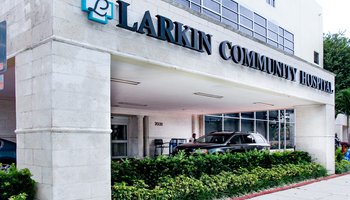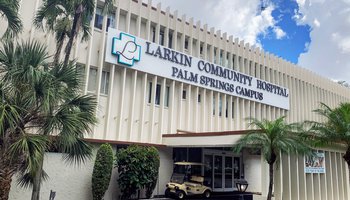- Home »
- Treatments & Services »
- Cancer (Oncology)
Hope is Here at
Larkin Cancer Center
Cancer & Oncology at Larkin
Larkin Health Systems provides a broad range of exceptional cancer services across our network. Each of our facilities is equipped with advanced technologies, Board Certified Physicians, and versatile medical professionals with decades of experience in treating moderate to life-threatening forms of cancer. This includes malignant (cancerous) tumor cells, benign (non-cancerous) tumor cells, and precancerous cells (learn more about these distinctions below).
Our Oncologists will perform a full assessment of your cancer's stage (which is the size and spread of your cancer) and grade (which is the aggressiveness/ speed of your cancers growth) to determine the best possible treatment plan for you.
Minimally Invasive Techniques
Leveraging minimally invasive techniques and cutting-edge technologies such as Gamma Knife Radiosurgery and Zap-X Radiosurgery, many of our treatments can be performed on an outpatient basis or with a minimal hospital stay. These advancements enable greater precision, lower rates of complications, and optimal patient recovery when compared to traditional techniques. We perform minimally invasive surgical techniques to remove cancer including robotic surgery (using the da Vinci surgical system), laparoscopic surgery, and endoscopic surgery.
These techniques allow surgeons to perform the entire operation with sophisticated technology and through small (1cm) incisions which decrease the chance of scarring, infections, and trauma when compared to "open" procedures and other traditional approaches.
Types of Treatment
Cancer treatment falls into two major categories, local treatments and systemic treatments, which can be used in conjunction or in a staged approach. Local treatments are those that target the cancer directly such as surgical techniques that physically remove the cancer and radiation therapy which uses high doses of radiation (externally or internally) to disrupt the DNA of the cell and its ability to divide, thereby killing the cell.
For example, Stereotactic Radiosurgery is an external form of radiation therapy that uses a machine outside the body (such as the Leksell Gamma Knife Perfexion and Zap-X Radiosurgery System) to deliver hundreds of beams of high energy radiation to a specific site. The goal of radiation therapy is to minimize radiation exposure to the healthy cells that surround the cancer.
Brachytherapy is an internal form of radiation therapy and involves the placement of solid radioactive materials such as seeds and capsules near the cancer cells or tumors. Systemic therapy is used to treat cancer cells within the entire body and can be delivered orally, through an IV, or injection. This includes chemotherapy, immunotherapy, targeted therapy, and hormone therapy
Learn more about the services we have to offer below or call us today 786-456-8399
| Service | Cancer Center at Larkin | Larkin South Miami | Larkin Palm Springs | Additional Facilities |
|---|---|---|---|---|
| Breast Cancer | ✓ | ✓ | ✓ | |
| Breast Cancer Surgery | ✓ | ✓ | ||
| Breast Reconstruction | ✓ | ✓ | ||
| Cancer Surgery (Surgical Oncology) | ✓ | ✓ | ||
| Chemotherapy | ✓ | |||
| Cancer Education and Support | ✓ | Miami Neuroscience Center | ||
| Gamma Knife Radiosurgery | Miami Neuroscience Center | |||
| Genetic Risk Education Service | ✓ | |||
| Gynecologic Oncology | ✓ | ✓ | ✓ | |
| Gynecologic Cancer Robotic Surgery | ✓ | |||
| Hematology/Oncology | ✓ | ✓ | ✓ | Larkin Outpatient Multi-Specialty Center |
| Interventional Radiology | ✓ | ✓ | Larkin Imaging Centers | |
| Nutrition Counseling & Consultation | ✓ | ✓ | ✓ | |
| Pain & Palliative Care | ✓ | ✓ | ✓ | |
| Prostate Cancer | ✓ | ✓ | ✓ | |
| Prostate Cancer Robotic Surgery | ✓ | |||
| Radiation Oncology | Miami Neuroscience Center | |||
| Skin Cancer | Larkin Outpatient Multi-Specialty Center & | |||
| Zap-X Radiosurgery | Miami Neuroscience Center |
Types of Tumors
Malignant tumor cells
- Cancerous cells that can spread/ invade surrounding tissue
- If they spread to the bloodstream or lymph nodes the cells can be carried anywhere in the body (liver, bones, brain, lungs, etc.). This is called metastatic cancer.
- Grow quicker than benign tumor cells
- Generally, won’t recur after treatment/ removal
Benign tumor cells
- Non-cancerous cells that won’t spread/ invade surrounding tissue (metastasize)
- Can become an issue if they pressure surrounding structures (vessels, spinal cord, brain, etc.)
- Grow slower than malignant tumor cells
- Can recur after treatment/ removal
Precancerous cells
- Cells that can develop into cancerous cells
- Won’t spread/ invade surrounding tissue (metastasize)
- Monitored through precancerous changes
- 1st Step: Hyperplasia
- Cells are growing faster/more significant than normal
- 2nd Step: Metaplasia
- Cells transform into another type of cell not commonly found in that area of the body
- 3rd Step: Dysplasia
- Severity of abnormality
- Mild
- Mild cell abnormality
- Unlikely to progress into cancer
- Moderate
- Moderate cell abnormality
- Greater tendency to go into cancer
- Severe
- Severe cell abnormality
- Likely to go into cancer
- Mild
- Grade of severity
- Low
- Slow progression
- Low chance of developing into cancer
- Can resolve without treatment
- High
- Advanced progression
- Higher chance of developing into cancer
- Low
- Severity of abnormality
- 4th Step: Carcinoma in situ
- Cancer cells that stay in the tissue they originated in and cannot break through the basement membrane
- 1st Step: Hyperplasia
Facilities
Cancer (Oncology) | Larkin Health Please Visit or Call The Following Facilities.
Physicians
Physicians Treating Cancer (Oncology) | Larkin Health.





